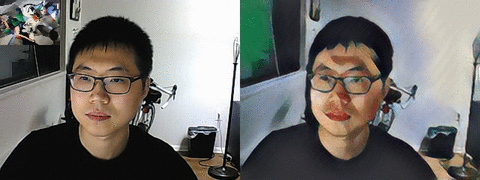Awesome
<table width="100%" border="0" cellspacing="15" cellpadding="0"> <tbody> <tr> <td> <b>Multi-style Generative Network for Real-time Transfer</b> [<a href="https://arxiv.org/pdf/1703.06953.pdf">arXiv</a>] [<a href="http://computervisionrutgers.github.io/MSG-Net/">project</a>] <br> <a href="http://hangzh.com/">Hang Zhang</a>, <a href="http://eceweb1.rutgers.edu/vision/dana.html">Kristin Dana</a> <pre> @article{zhang2017multistyle, title={Multi-style Generative Network for Real-time Transfer}, author={Zhang, Hang and Dana, Kristin}, journal={arXiv preprint arXiv:1703.06953}, year={2017} } </pre> </td> <td width="440"><a><img src ="https://raw.githubusercontent.com/zhanghang1989/MSG-Net/master/images/figure1.jpg" width="420px" border="1"></a></td> </tr> </tbody> </table>Installation
We also provide PyTorch implementation and MXNet implementation. Please install Torch7 with cuda and cudnn support. The code has been tested on Ubuntu 16.04 with Titan X Pascal and Maxwell.
luarocks install https://raw.githubusercontent.com/zhanghang1989/MSG-Net/master/texture-scm-1.rockspec
Test and Demo
- Clone the repo and download pre-trained models
git clone git@github.com:zhanghang1989/MSG-Net.git cd MSG-Net/experiments bash models/download_models.sh - Web Camera Demo
qlua webcam.lua
- Test on Image
th test.lua -input_image images/content/venice-boat.jpg -image_size 1024 eog stylized
<img src ="images/stylized/1.jpg" width="260px" /> <img src ="images/stylized/2.jpg" width="260px" /> <img src ="images/stylized/3.jpg" width="260px" /> <img src ="images/stylized/4.jpg" width="260px" /> <img src ="images/stylized/5.jpg" width="260px" /> <img src ="images/stylized/6.jpg" width="260px" /> <img src ="images/stylized/7.jpg" width="260px" /> <img src ="images/stylized/8.jpg" width="260px" /> <img src ="images/stylized/9.jpg" width="260px" />
Train Your Own Model
Please follow this tutorial to train a new model.
Release Timeline
- 03/20/2017 we have released the demo video.
- 03/24/2017 We have released ArXiv paper and test code with pre-trained models.
- 04/09/2017 We have released the training code.
- 04/24/2017 Please checkout our PyTorch implementation.
Acknowledgement
The code benefits from outstanding prior work and their implementations including:
- Texture Networks: Feed-forward Synthesis of Textures and Stylized Images by Ulyanov et al. ICML 2016. (code)
- Perceptual Losses for Real-Time Style Transfer and Super-Resolution by Johnson et al. ECCV 2016 (code)
- Image Style Transfer Using Convolutional Neural Networks by Gatys et al. CVPR 2016 and its torch implementation code by Johnson.